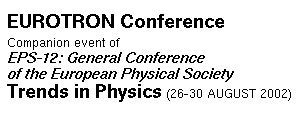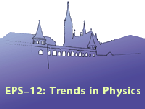 |
 |
 |
We celebrate the centenary of Eugene Wigner who was almost of the same “quantum age” as Heisenberg and Pauli. However, the latter were intimately involved in adapting Bohr’s quantum theory to the mathematical description of atomic spectroscopy and were among the main architects of the upgrading of old quantum theory into quantum mechanics (QM). By contrast Wigner graduated in 1925 as chemical engineer in Berlin. Although he was fascinated by the quantum theory he was exposed to at the Berlin Colloquium, he returned to Budapest to work in the tanning factory where his father was director. His mentor Michael Polanyi soon rescued him by getting him invited as an x-ray technician to Berlin. The factory was a total dead-end, but I will argue that the chemical training and his sensitization to mathematics in school were positive influences, since QM was basically a novel confluence of physics, mathematics and chemistry. (See the excellent summary in the November 1977 issue of “Fizikai Szemle”.)
Wigner’s training prepared him for an important role in the Manhattan Project, where he was put in charge of constructing the plutonium producing Hanford facility. He guided the industrial contractor to upgrade traditional chemical engineering techniques to include nuclear phenomena, thus solving the novel cooling problems.
Years before this event, Wigner’s background already helped to shape his contribution to fundamental QM, although in a subtle way. His early experience in x-ray crystallography brought him in contact with symmetry. This resonated with his liking for mathematics stimulated in gymnasium and greatly supported by his prodigy friend Johnny von Neumann. All this added up to a program of applying the theory of group representations to atomic spectroscopy. The papers that he wrote in 1927-9, some of them jointly with Neumann, are seminal in the field. He collected the material in a widely read book that helped to overcome the community’s aversion to “Gruppenpest”. The issue was the conflict between the analysis of the continuum and the discontinuity of algebra, reflecting the discontinuity of chemistry.
Wigner extended the range of his activities to molecules, solids and nuclear physics, always focusing on problems of symmetry and invariance. His nuclear physics achievements and work on symmetry earned him the Nobel Prize in 1963. Wigner’s highly mathematical theory of the Lorentz group will be discussed. His tensor-space parametrization as against the complex spinors of Dirac raises problems of ways to choose the optimal mathematical formalism in the natural sciences.
The following files are available:
- abstracttisza.pdf [9444 bytes]
- abstracttisza.doc [40448 bytes]
Eurotron Conference is supported by European Commission, High-Level Scientific Conferences